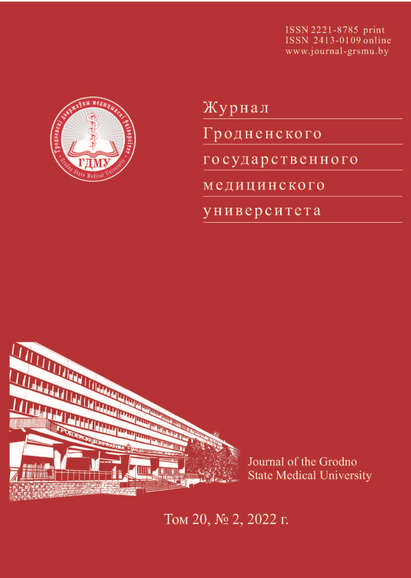РОЛЬ ГЕНОТИПА ВИРУСА ПАПИЛЛОМЫ ЧЕЛОВЕКА 16 В ПАТОЛОГИИ РАКА ШЕЙКИ МАТКИ
Аннотация
Рак шейки матки является четвертым по частоте злокачественным новообразованием у женщин во всем мире и третьим в Ираке. Одной из причин этого является вирус папилломы человека (ВПЧ), который обнаруживается у 70% жителей Ирака. Настоящее исследование направлено на поиск механизма патогенеза, которым обладает генотип ВПЧ16, при данном заболевании.
Литература
International Collaboration of Epidemiological Studies of Cervical Cancer; Appleby P, Beral V, Berrington de González A, Colin D, Franceschi S, Goodhill A, Green J, Peto J, Plummer M, Sweetland S. Cervical cancer and hormonal contraceptives: collaborative reanalysis of individual data for 16,573 women with cervical cancer and 35,509 women without cervical cancer from 24 epidemiological studies. Lancet. 2007;370(9599):1609-1621. https://doi.org/10.1016/S0140-6736(07)61684-5.
Arbyn M, Castellsagué X, de Sanjosé S, Bruni L, Saraiya M, Bray F, Ferlay J. Worldwide burden of cervical cancer in 2008. Ann Oncol. 2011;22(12):2675-2686. https://doi.org/10.1093/annonc/mdr015.
Saxena U, Sauvaget C, Sankaranarayanan R. Evidencebased screening, early diagnosis and treatment strategy of cervical cancer for national policy in low-resource countries: example of India. Asian Pac J Cancer Prev. 2012;13(4):1699-1703. https://doi.org/10.7314/apjcp.2012.13.4.1699.
Hang D, Yin Y, Han J, Jiang J, Ma H, Xie S, Feng X, Zhang K, Hu Z, Shen H, Clifford GM, Dai M, Li N. Analysis of human papillomavirus 16 variants and risk for cervical cancer in Chinese population. Virology. 2016;488:156-161. https://doi.org/10.1016/j.virol.2015.11.016.
da Silva RL, da Silva Batista Z, Bastos GR, Cunha APA, Figueiredo FV, de Castro LO, Dos Anjos Pereira L, da Silva MACN, Vidal FCB, Barros MC, da Costa Fraga E, Brito LMO, do Carmo Lacerda Barbosa M, Moreira MÂM, do Desterro Soares Brandão Nascimento M. Role of HPV 16 variants among cervical carcinoma samples from Northeastern Brazil. BMC Womens Health. 2020;20(1):162. https://doi.org/10.1186/s12905-020-01035-0.
Vidal JP, Felix SP, Chaves CB, Patury P, Franco VF, de Morais EA, de Carvalho NA, Carvalho AC, Almeida Neto OF, Vieira LM, Correa FM, Martins LF, Negrão A, de Almeida LM, Moreira MA. Genetic diversity of HPV16 and HPV18 in Brazilian patients with invasive cervical cancer. J Med Virol. 2016;88(7):1279-1287. https://doi.org/10.1002/jmv.24458.
Doorbar J, Egawa N, Griffin H, Kranjec C, Murakami I. Human papillomavirus molecular biology and disease association. Rev Med Virol. 2015;25(Suppl 1):2-23. https://doi.org/10.1002/rmv.1822.
Borbély ÁA, Murvai M, Kónya J, Beck Z, Gergely L, Li F, Veress G. Effects of human papillomavirus Type 16 oncoproteins on survivin gene expression. J Gen Virol. 2006;87(Pt 2):287-294. https://doi.org/10.1099/vir.0.81067-0.
Bhatla N, Berek JS, Cuello Fredes M, Denny LA, Grenman S, Karunaratne K, Kehoe ST, Konishi I, Olawaiye AB, Prat J, Sankaranarayanan R, Brierley J, Mutch D, Querleu D, Cibula D, Quinn M, Botha H, Sigurd L, Rice L, Ryu HS, Ngan H, Mäenpää J, Andrijono A, Purwoto G, Maheshwari A, et al. Revised FIGO staging for carcinoma of the cervix uteri. Int J Gynecol Obstet. 2019;145(1):129-135. https://doi.org/10.1002/ijgo.12749.
Burk RD, Harari A, Chen Z. Human papillomavirus genome variants. Virology. 2013;445(1-2):232-243. https://doi.org/10.1016/j.virol.2013.07.018.
Volpini LPB, Boldrini NAT, de Freitas LB, Miranda AE, Spano LC. The high prevalence of HPV and HPV16 European variants in cervical and anal samples of HIV-seropositive women with normal pap test results. PLoS One 2017;12(4):e0176422. https://doi.org/10.1371/journal.pone.0176422.
Tan G, Duan M, Li Y, Zhang N, Zhang W, Li B, Qu P. Distribution of HPV 16 E6 gene variants in screening women and its associations with cervical lesions progression. Virus Res. 2019;273:197740. https://doi.org/10.1016/j.virusres.2019.197740.
Altekruse SF, Lacey JV Jr, Brinton LA, Gravitt PE, Silverberg SG, Barnes WA Jr, Greenberg MD, Hadjimichael OC, McGowan L, Mortel R, Schwartz PE, Hildesheim A. Comparison of human papillomavirus genotypes, sexual, and reproductive risk factors of cervical adenocarcinoma and squamous cell carcinoma: Northeastern United States. Am J Obstet Gynecol. 2003;188(3):657-663. https://doi.org/10.1067/mob.2003.132.
Rogers A, Waltke M, Angeletti PC. Evolutionary variation of papillomavirus E2 protein and E2 binding sites. Virol J. 2011;8:379. https://doi.org/10.1186/1743-422X-8-379.
Thomas M, Narayan N, Pim D, Tomaić V, Massimi P, Nagasaka K, Kranjec C, Gammoh N, Banks L. Human papillomaviruses, cervical cancer and cell polarity. Oncogene. 2008;27(55):7018-7030. https://doi.org/10.1038/onc.2008.351.
Chin MT, Hirochika R, Hirochika H, Broker TR, Chow LT. Regulation of human papillomavirus type 11 enhancer and E6 promoter by activating and repressing proteins from the E2 open reading frame: functional and biochemical studies. J Virol. 1988;62(8):2994-3002. https://doi.org/10.1128/JVI.62.8.2994-3002.1988.
Lakspere T, Tynell J, Kaloinen M, Vanlede M, Parsons A, Ikonen N, Kallio-Kokko H, Kantele A, Mattila P, Almusa H, Julkunen I. Full-genome sequences of influenza A (H1N1) pdm09 viruses isolated from Finnish patients from 2009 to 2013. Genome Announcs. 2014;2(1):e01004-01013. https://doi.org/10.1128/genomeA.01004-13.
Howie HL, Katzenellenbogen RA, Galloway DA. Papillomavirus E6 proteins. Virology. 2009;384(2):324-334. https://doi.org/10.1016/j.virol.2008.11.017.
Münger K, Howley PM. Human papillomavirus immortalization and transformation functions. Virus res. 2002;89(2):213-228. https://doi.org/10.1016/s0168-1702(02)00190-9.
Galloway DA, Laimins LA. Human papillomaviruses: Shared and distinct pathways for pathogenesis. Curr Opin Virol. 2015;14:87-92. https://doi.org/10.1016/j.coviro.2015.09.001.
Comparetto C, Borruto F. Human Papillomavirus Infection: Overview. In: Smith HB, ed. Handbook on human papillomavirus: prevalence, detection and management. New York: Nova Science Publishers; 2013. Ch. 1; p. 1-137.
Chowdhury SM. Graphene nanoribbons elicit cell specific uptake and drug delivery via activation of epidermal growth factor receptors [doctoral dissertation]. New York: State University of New York at Stony Brook; 2014.
Wold WS, Ison MG. Adenovirus. In: Knipe DM, Howley P. Fields Virology. 6th ed. Lippincott, Williams & Wilkins; 2013. p. 1732-1767.
Fiorucci G, Chiantore MV, Mangino G, Romeo G. MicroRNAs in virus-induced tumorigenesis and IFN system. Cytokine Growth Factor Rev. 2015;26(2):183-194. https://doi.org/10.1016/j.cytogfr.2014.11.002.
Insinga RP, Dasbach EJ, Elbasha EH, Liaw K-L, Barr E. Progression and regression of incident cervical HPV 6, 11, 16 and 18 infections in young women. Infect Agent Cancer. 2007;2:15. https://doi.org/10.1186/1750-9378-2-15.
Brianti P, De Flammineis E, Mercuri SR. Review of HPV-related diseases and cancers. New Microbiol. 2017;40(2):80-85.
Stanley M. Pathology and epidemiology of HPV infection in females. Gynecol Oncol. 2010;117(2 Suppl):S5-10. https://doi.org/10.1016/j.ygyno.2010.01.024.
Mirabello L, Clarke MA, Nelson CW, Dean M, Wentzensen N, Yeager M, Cullen M, Boland JF, Schiffman M, Burk RD; NCI HPV Workshop. The intersection of HPV epidemiology, genomics and mechanistic studies of HPVmediated carcinogenesis. Viruses. 2018;10(2):80. https://doi.org/10.3390/v10020080.
Skinner SR, Wheeler CM, Romanowski B, Castellsagué X, Lazcano-Ponce E, Del Rosario-Raymundo MR, Vallejos C, Minkina G, Pereira Da Silva D, McNeil S, Prilepskaya V, Gogotadze I, Money D, Garland SM, Romanenko V, Harper DM, Levin MJ, Chatterjee A, Geeraerts B, Struyf F, Dubin G, Bozonnat MC, Rosillon D, Baril L; VIVIANE Study Group. Progression of HPV infection to detectable cervical lesions or clearance in adult women: analysis of the control arm of the VIVIANE study. Int J Cancer. 2016;138(10):2428-2438. https://doi.org/10.1002/ijc.29971.
Insinga RP, Dasbach EJ, Elbasha EH. Epidemiologic natural history and clinical management of Human Papillomavirus (HPV) Disease: a critical and systematic review of the literature in the development of an HPV dynamic transmission model. BMC Infect Dis. 2009;9:119. https://doi.org/10.1186/1471-2334-9-119.
Chan CK, Aimagambetova G, Ukybassova T, Kongrtay K, Azizan A. Human Papillomavirus Infection and Cervical Cancer: Epidemiology, Screening, and Vaccination – Review of Current Perspectives. J Oncol. 2019;2019:3257939. https://doi.org/10.1155/2019/3257939.
Rositch AF, Burke AE, Viscidi RP, Silver MI, Chang K, Gravitt PE. Contributions of recent and past sexual partnerships on incident human papillomavirus detection: acquisition and reactivation in older women. Cancer Res. 2012;72(23):6183-6190. https://doi.org/10.1158/0008-5472.CAN-12-2635.
Gravitt PE, Rositch AF, Silver MI, Marks MA, Chang K, Burke AE, Viscidi RP. A cohort effect of the sexual revolution may be masking an increase in human papillomavirus detection at menopause in the United States. J Infect Dis. 2013;207(2):272-280. https://doi.org/10.1093/infdis/jis660.
McCredie MR, Sharples KJ, Paul C, Baranyai J, Medley G, Jones RW, Skegg DC. Natural history of cervical neoplasia and risk of invasive cancer in women with cervical intraepithelial neoplasia 3: a retrospective cohort study. Lancet Oncol. 2008;9(5):425-434. https://doi.org/10.1016/S1470-2045(08)70103-7.
Rodríguez AC, Schiffman M, Herrero R, Wacholder S, Hildesheim A, Castle PE, Solomon D, Burk R; Proyecto Epidemiológico Guanacaste Group. Rapid clearance of human papillomavirus and implications for clinical focus on persistent infections. J Natl Cancer Inst. 2008;100(7):513-517. https://doi.org/10.1093/jnci/djn044.
World Health Organization. Comprehensive Cervical Cancer Control: A Guide to Essential Practice. 2nd ed. Geneva, Switzerland; 2014. 364 p.
Ronco G, Dillner J, Elfström KM, Tunesi S, Snijders PJ, Arbyn M, Kitchener H, Segnan N, Gilham C, GiorgiRossi P, Berkhof J, Peto J, Meijer CJ; International HPV screening working group. Efficacy of HPV-based screening for prevention of invasive cervical cancer: follow-up of four European randomised controlled trials. Lancet. 2014;383(9916):524-532. https://doi.org/10.1016/S0140-6736(13)62218-7.
Kjær SK, Frederiksen K, Munk C, Iftner T. Long-term absolute risk of cervical intraepithelial neoplasia grade 3 or worse following human papillomavirus infection: role of persistence. J Natl Cancer Inst. 2010;102(19):1478-1488. https://doi.org/10.1093/jnci/djq356.
Hong D, Ye F, Lu W, Hu Y, Wan X, Chen Y, Xie X. Methylation status of the long control region of HPV 16 in clinical cervical specimens. Mol Med Rep. 2008;1(4):555-560. https://doi.org/10.3892/mmr.1.4.555.
Lehoux M, D’Abramo CM, Archambault J. Molecular mechanisms of human papillomavirus-induced carcinogenesis. Public Health Genomics. 2009;12(5-6):268-280. https://doi.org/10.1159/000214918.
Jing Y, Wang T, Chen Z, Ding X, Xu J, Mu X, Cao M, Chen H. Phylogeny and polymorphism in the long control regions E6, E7, and L1 of HPV Type 56 in women from southwest China. Mol Med Rep. 2018;17(5):7131-7141. https://doi.org/10.3892/mmr.2018.8743.
Thomas MC, Chiang C-M. E6 oncoprotein represses p53-dependent gene activation via inhibition of protein acetylation independently of inducing p53 degradation. Mol Cell. 2005;17(2):251-264. https://doi.org/10.1016/j.molcel.2004.12.016.
Riley RR, Duensing S, Brake T, Münger K, Lambert PF, Arbeit JM. Dissection of human papillomavirus E6 and E7 function in transgenic mouse models of cervical carcinogenesis. Cancer Res. 2003;63(16):4862-4871.
Hoste G, Vossaert K, Poppe WA. The Clinical Role of HPV Testing in Primary and Secondary Cervical Cancer Screening. Obstet Gynecol Int. 2013;2013:610373. https://doi.org/10.1155/2013/610373.
Tjalma WA, Van Waes TR, Van den Eeden LE, Bogers JJ. Role of human papillomavirus in the carcinogenesis of squamous cell carcinoma and adenocarcinoma of the cervix. Best Pract Res Clin Obstet Gynaecol. 2005;19(4):469-483. https://doi.org/10.1016/j.bpobgyn.2005.02.002.
Moreno-Acosta P, Romero-Rojas A, Vial N, Huertas A, Acosta J, Mayorga D, Carrillo S, Molano M, Gamboa O, Cotes M, Casadiego C, Vallard A, Magne N. Persistent High-Risk HPV Infection and Molecular Changes Related to the Development of Cervical Cancer. Case Rep Obstet Gynecol. 2020;2020:6806857. https://doi.org/10.1155/2020/6806857.
Habbous S, Pang V, Eng L, Xu W, Kurtz G, Liu FF, Mackay H, Amir E, Liu G. P53 Arg72Pro polymorphism, HPV status and initiation, progression, and development of cervical cancer: a systematic review and meta-analysis. Clin Cancer Res. 2012;18(23):6407-6415. https://doi.org/10.1158/1078-0432.CCR-12-1983.
Huang Y-F, Shen M-R, Hsu K-F, Cheng Y-M, Chou C-Y. Clinical implications of insulin-like growth factor 1 system in early-stage cervical cancer. Br J Cancer. 2008;99(7):1096-1102. https://doi.org/10.1038/sj.bjc.6604661.
Zacapala-Gómez AE, Del Moral-Hernández O, VillegasSepúlveda N, Hidalgo-Miranda A, Romero-Córdoba SL, Beltrán-Anaya FO, Leyva-Vázquez MA, Alarcón-Romero Ldel C, Illades-Aguiar B. Changes in global gene expression profiles induced by HPV 16 E6 oncoprotein variants in cervical carcinoma C33-A cells. Virology. 2016;488:187-195. https://doi.org/10.1016/j.virol.2015.11.017.
Moreno-Acosta P, Gamboa O, Sanchez de Gomez M, Cendales R, Diaz GD, Romero A, Balart Serra J, Conrado Z, Levy A, Chargari C, Magné N. IGF1R gene expression as a predictive marker of response to ionizing radiation for patients with locally advanced HPV16-positive cervical cancer. Anticancer Res. 2012;32(10):4319-4325.
Cheah PL, Looi LM, Ng MH, Sivanesaratnam V. Telomerase activation and human papillomavirus infection in invasive uterine cervical carcinoma in a set of Malaysian patients. J Clin Pathol. 2002;55(1):22-26. https://doi.org/10.1136/jcp.55.1.22.
Jawanjal P, Salhan S, Dhawan I, Rath G. Comparative analysis of p53 and p21 proteins in normal cervix and HPV associated precancerous and cancerous lesions of cervix. J Anat Soc India. 2015;64(1):3-11. https://doi.org/10.1016/j.jasi.2015.05.001.
Sağnıç, S. Human Papillomavirus and Cervical Cancer. In: Rajkumar, R., editor. Cervical Cancer - A Global Public Health Treatise [Internet]. London: IntechOpen; 2021 [cited 2022 Mar 30]. Available from: https://www.intechopen.com/chapters/77729. https://doi.org/10.5772/intechopen.98490.































